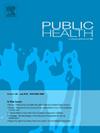Virtual cycling in urban green and blue vs gray spaces: The efficacy of mental health and physical activity
IF 3.9
3区 医学
Q1 PUBLIC, ENVIRONMENTAL & OCCUPATIONAL HEALTH
引用次数: 0
Abstract
Objectives
An urban environment may be stressful, potentially leading to poor mental health. Natural elements are important in urban environments with many restorative and potential health benefits compared to artificial elements. Virtual reality can simulate an urban environment in a digital world. The purpose of this study was to compare the different effects on mental health and physical activity outcomes between cycling in virtual urban green-blue and gray spaces.
Study design
A randomized controlled trial conducted from September 2021 to June 2022.
Methods
In total, 62 participants were randomly assigned to either the green-blue or gray group. All participants received a virtual cycling intervention for 30 min per session, once a week for 12 weeks. Different 360° videos of urban views were shown on head-mounted display headsets between the two groups. Virtual green and blue spaces consisted of bike trails that passed through natural elements with landscapes and waterscapes, while virtual gray spaces consisted of bike trails that passed through more-artificial elements in cities. Outcomes at the baseline and post-intervention were measured by self-reported questionnaires and objective instruments.
Results
Participants in the green-blue group had improved positive affect, perceived stress, and light-intensity physical activity compared to the gray group. Participants in the green-blue group had lower perceived exertion and virtual reality sickness, and higher enjoyment than those in the gray group.
Conclusions
Virtual reality cycling in the urban green and blue spaces is recommended for mental health and PA promotion for urban adult populations.
城市绿蓝空间与灰空间中的虚拟自行车:心理健康和身体活动的功效
目的城市环境压力大,可能导致心理健康状况不佳。与人工元素相比,自然元素在城市环境中很重要,具有许多恢复和潜在的健康益处。虚拟现实可以模拟数字世界中的城市环境。本研究的目的是比较在虚拟城市绿蓝空间和灰色空间中骑自行车对心理健康和身体活动结果的不同影响。研究设计一项随机对照试验,于2021年9月至2022年6月进行。方法共有62名参与者被随机分配到绿蓝组和灰蓝组。所有参与者都接受了每次30分钟的虚拟自行车干预,每周一次,持续12周。两组人通过头戴式耳机播放不同的360°城市景观视频。虚拟的绿色和蓝色空间由自行车道组成,穿过带有景观和水景的自然元素,而虚拟的灰色空间由自行车道组成,穿过城市中更多的人工元素。基线和干预后的结果通过自我报告问卷和客观仪器测量。结果与灰色组相比,绿蓝组的参与者在积极情绪、感知压力和轻强度体力活动方面都有所改善。绿蓝色组的参与者比灰色组的参与者更少感受到劳累和虚拟现实疾病,更享受。结论建议在城市绿蓝空间开展虚拟现实骑行活动,促进城市成年人心理健康和心理健康。
本文章由计算机程序翻译,如有差异,请以英文原文为准。
求助全文
约1分钟内获得全文
求助全文
来源期刊

Public Health
医学-公共卫生、环境卫生与职业卫生
CiteScore
7.60
自引率
0.00%
发文量
280
审稿时长
37 days
期刊介绍:
Public Health is an international, multidisciplinary peer-reviewed journal. It publishes original papers, reviews and short reports on all aspects of the science, philosophy, and practice of public health.
 求助内容:
求助内容: 应助结果提醒方式:
应助结果提醒方式:


